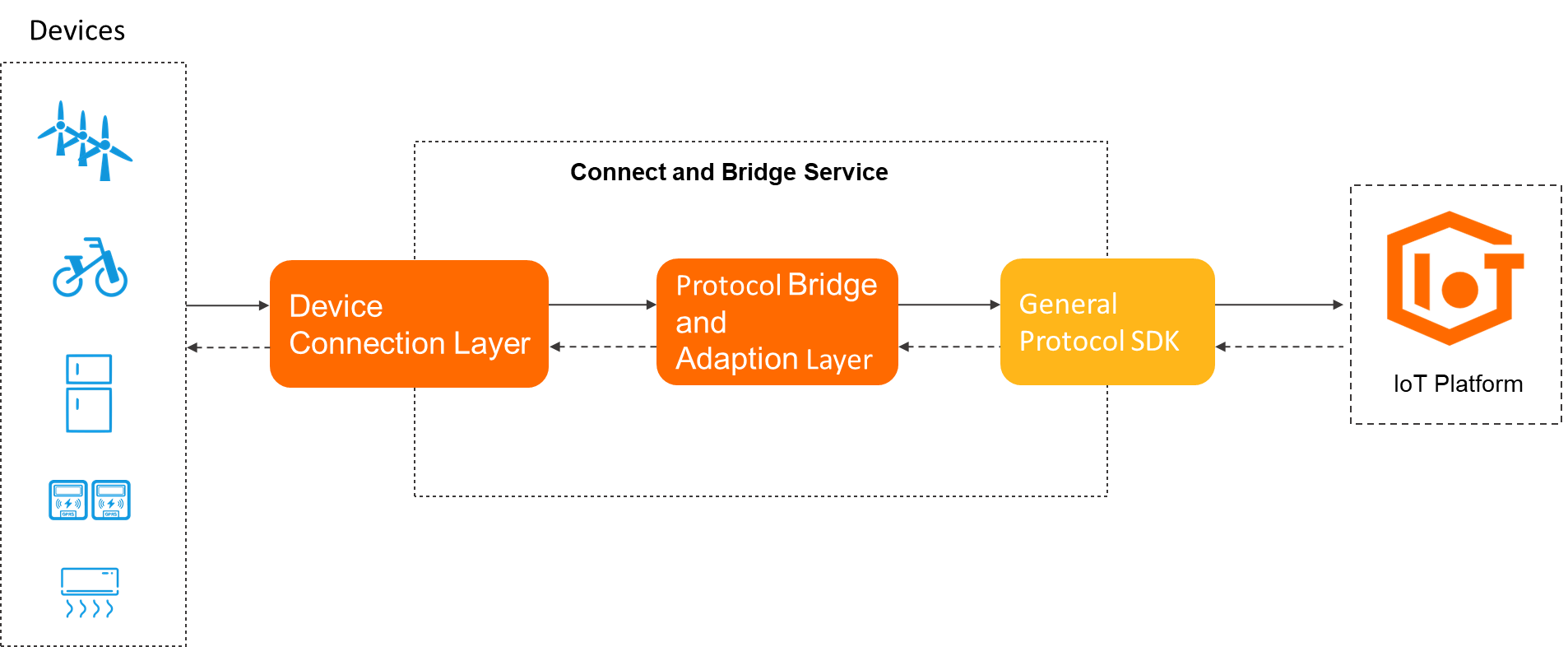Alibaba Cloud IoT Platform supports communication over Message Queuing Telemetry Transport (MQTT), Constrained Application Protocol (CoAP), or HTTP. Other types of protocols, such as the fire protection agreement GB/T 26875.3-2011, and Modbus,, are not supported. If devices cannot be directly connected to IoT Platform in specific cases, you can use the IoT as Bridge SDK to deploy a bridging service and establish connections between the devices or the bridging service and IoT Platform.
The IoT as Bridge SDK is supported only in the following regions: China (Shanghai), Germany (Frankfurt), and US (Virginia).
Architecture
The IoT as Bridge SDK is a self-adaptive protocol framework. You can use the SDK to deploy a bridging service and achieve communication between IoT Platform and your devices.

Scenario
A device cannot be directly connected to IoT Platform due to network limits or hardware limits.
A device uses a protocol that is not supported by IoT Platform.
A connection is established between a device and a bridge server. You want to connect the device to IoT Platform without the need to modify the settings of the device and protocol.
A device is connected to a server and requires more services.
The device requires to use IoT Platform features, such as the OTA update feature.
The device needs to be connected to IoT Platform.
The device requires additional processing logic to meet business requirements.
Features
The IoT as Bridge SDK allows a bridge server to communicate with IoT Platform.
Basic features:
Allows you to manage configurations by using a configuration file.
Allows you to manage device connections.
Provides upstream communication capabilities.
Provides downstream communication capabilities.
NoteDownstream communication does not support synchronous service revocation or Revert-Remote Procedure Call (RRPC) communication.
Advanced features:
Allows you to manage configurations by using API operations.
Provides API operations to submit one or more properties and events, update tags, set properties, and call services.
Terms
Term | Description |
device | A device in an actual IoT scenario. The device cannot directly communicate with IoT Platform by using a supported protocol in a real IoT scenario. |
bridge server | The server to which the device is connected. This server uses a specific protocol to communicate with the device and uses the IoT as Bridge SDK to communicate with IoT Platform. |
original protocol | The specific protocol that is used between the device and the bridge server. The IoT as Bridge SDK does not contain the definition and implementation of the original protocol. |
original device identifier | The unique identifier that is used by the device to communicate with the bridge server over the original protocol. The IoT as Bridge SDK provides the originalIdentity parameter to specify the identifier of the device. |
device certificate | The device certificate that is obtained after you register a device in IoT Platform. The certificate information includes ProductKey, DeviceName, and DeviceSecret. If you use the IoT as Bridge SDK, you do not need to burn the device certificate on the device. However, you must configure the devices.conf file. The bridge maps the originalIdentity parameter of the device to the device certificate. |
bridge certificate | The bridge certificate that is obtained after you register a bridge in IoT Platform. The certificate information includes ProductKey, DeviceName, and DeviceSecret. The bridge certificate uniquely identifies the bridge in IoT Platform. |
Develop and deploy a bridging service
Log on to the IoT Platform console, create a product and device, and then obtain the certificate of the bridge.
For more information, see Create a product, Create a device, and Create multiple devices at a time.
You must specify the certificate of the bridge when you configure the IoT as Bridge SDK.
NoteThe bridge is a virtual device. You can use a device certificate as the certificate of the bridge.
Configure the IoT as Bridge SDK.
For more information, see Use the basic features and Use the advanced features.
NoteOnly IoT as Bridge SDK for Java is provided. You can develop the SDK only by using JDK 1.8 or later.
Deploy the developed bridging service.
To ensure high scalability, you can use Alibaba Cloud services such as Elastic Compute Service (ECS) and Server Load Balancer (SLB) to deploy the bridging service in Alibaba Cloud.
To ensure trusted communication, you can deploy the service on an on-premises host.
The following figure shows the procedure of using ECS to deploy the bridging service.
